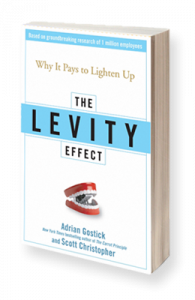|
|
|
Friday, October 30th, 2009
 Philip Mydlach wrote a great article saying that to create a better environment, where creativity and success can flourish, the management team should be like a fudgsicle—consistent all the way through. Philip Mydlach wrote a great article saying that to create a better environment, where creativity and success can flourish, the management team should be like a fudgsicle—consistent all the way through.
Your management team’s behavior sets the tone for the entire corporation. So it better be consistent, predictable and true to your core values.
Absolutely true, as is the need for clearly communicating those values and not tolerating managers who don’t support them.
But achieving your fudgsicle is easier if you include a preliminary step that Mydlach doesn’t mention.
That step is using your culture as a filter in all your hiring—especially when hiring management and most importantly the executive team.
10 years ago I wrote and article for MSDN about how to use company culture as a screening tool to avoid hiring turkeys of any kind at all levels.
With the sighting of “economic green shoots” this seems a good time to revisit it (with some updating).
Don’t Hire Turkeys!
Use Your Culture as an Attraction, Screening and Retention Tool
to Turkey-Proof Your Company.
Companies don’t create people—people create companies.
All companies have a culture composed of its core values and beliefs, essentially its corporate MAP (mindset, attitude, philosophy™), and it’s why people join the company and why they leave.
Generally, people don’t like bureaucracy, politics, backstabbing, etc., but when business stress goes up, or business heats up, cultural focus is often overwhelmed by other priorities.
In startups, it’s easier to hire people who are culturally compatible, because the founders first hire all their friends, and then their friend’s friends.
After that, when new positions have to be filled the only people available are strangers.
So how do you hire strangers and not lose your culture?
Since your culture is a product of your people, hire only people with matching or synergistic attitudes. The trick is to have a turkey sieve that will automatically screen out most of the misfits and turn on the candidates with the right values and attitudes.
Here is how you do it.
- Your sieve is an accurate description of your real culture.
- It must be hard copy (write it out), fully publicized (everyone needs to know and talk about it), and, most important of all, it must be real.
- Email it to every candidate before their interview and be sure that everyone talks about the culture during the interview and sells the company’s commitment to it.
- Everybody interviewing needs to listen carefully to what the candidate is saying and not saying; don’t expect a candidate to openly admit to behaviors that don’t fit the company MAP, since she may be unaware of them, may assume that your culture is more talk than walk or consider it something that won’t apply to her.
- Red flags must be followed up, not ignored because of skills or charm.
- Consider the various environments in which she’s worked; find out if she agreed with how things were done, and, more importantly, how she would have done them if she had been in control.
- Whether or not the candidate is a manager, you want to learn about her management MAP, approaches to managing and work function methods.
- Probing people to understand what their responses, conscious as well as intuitive, are to a variety of situations reveals how they will act, react, and contribute to your company’s culture and its success.
Finally, it is up to the hiring manager to shield the candidate from external decision pressures, e.g., friends already employed by the company, headhunters, etc.
Above all, it is necessary to give all candidates a face-saving way to withdraw their candidacy and say no to the opportunity. If they don’t have a graceful way of exiting the interview process they may pursue, receive, and accept an offer, even though they know deep down it is not a good decision.
A bad match can do major damage to the company, people’s morale, and even the candidate, so a “no” is actually a good thing.
Remember, the goal is to keep your company culture consistent and flexible as you grow. From the time you start this process, you need to consciously identify what you have, decide what you want it to be, publicize it, and use it as a sieve to be sure that everyone who joins, fits.
Use your cultural sieve uniformly at all levels all the time. If someone sneaks through, which is bound to happen occasionally, admit the error quickly and give her the opportunity to change, but if she persists then she has to go.
Do this and watch retention, creativity, productivity and morale surge ever higher.
Stop doing it at your own risk.
Image credit: daveyll on flickr
Posted in Business info, Culture, Hiring, Motivation, Retention | No Comments »
Friday, October 9th, 2009
This has been levity week and to wrap it up I have a guest post from Adrian Gostick and Scott Christopher, authors of The Levity Effect. The book is excellent and don’t miss their blog.
 As a public speaker and trainer we’ve discovered over the past two decades that the most memorable presentations and the speakers with the highest evaluations have one thing in common: humor. Well, two things really: humor and fun. They’re not the same thing, though they spring from the same well: Levity. (That’s enough colons to open a proctology lab, btw.) As a public speaker and trainer we’ve discovered over the past two decades that the most memorable presentations and the speakers with the highest evaluations have one thing in common: humor. Well, two things really: humor and fun. They’re not the same thing, though they spring from the same well: Levity. (That’s enough colons to open a proctology lab, btw.)
Levity, as defined by your average dictionary, smacks of negativity—“inappropriate,” “frivolous,” “flippant,” “trivial,” even “giddy.” Giddy?
With descriptors like those, levity’s workplace value ranks well below Communication, Trust and Teamwork and maybe just a molecule above Sexual Harassment, Bullying, and Embezzling.
Let’s face it, levity is misunderstood. After all, who wants a “goof off” to handle company finances, deal with an irate customer, or worse, pilot the company jet?
But the truth is, it pays to lighten up. And that’s the definition of levity that we like best—a lightness of manner. It has a more positive ring to it. In our definition of levity we add other image words: upbeat, patient, respectful, good-natured, joyous, and possibly witty, clever, even hilarious. And not just in the realm of public speaking and training.
You may think it’s hard to measure the return on investment of levity at work—whether a go-cart outing, online vacation photo contest, or a well-timed one liner—but we’ve found a bevy of successful leaders in companies such as Boeing, KPMG and Nike who attest that fun is an essential component of their people, business and innovation strategies.
Our book, “The Levity Effect: Why It Pays to Lighten Up,” is backed up by a one million-person research study and offers up lots of ways to make money while making merry. Here are a few quick ideas that paint the proper picture of Levity…
- If they’re laughing, they’re listening: Whether you’re about to make a presentation to senior management to get funding for your big idea (outsourcing to primates), pitching a sales prospect who could make your year, or trying to engage a troop of distracted Campfire Girls, great communicators know that a little humor goes a long way toward creating unforgettable messages.
- Comedy can coax creativity: The work world isn’t suffering from a dearth of tedious, stiff brainstorming sessions. Research shows you can boost creativity scores by exposing people to humor or play before you start a meeting.
- Laugh all the way to the bank: Managers who use more levity experience higher employee productivity, engagement and retention. People with a sense of humor climb the corporate ladder more quickly and earn more money than their peers. And executives hire and promote the humorous more often than the dour. Wouldn’t you?
- Put a spring in your voicemail: As soon as you get into the office today, lighten up your tired voicemail with some quick company trivia or at least a modicum of joy in your voice. That is, after all, how we greet people face to
Posted in Business info, Communication, Culture, Motivation, Retention | No Comments »
Tuesday, October 6th, 2009
 Before you can implement any of the ideas in The Levity Effect you need to take inventory and be sure that your MAP (mindset, attitude, philosophy™) is in tune with the idea. Being in tune with levity is much more a matter of how you think than how well your sense of humor works. Before you can implement any of the ideas in The Levity Effect you need to take inventory and be sure that your MAP (mindset, attitude, philosophy™) is in tune with the idea. Being in tune with levity is much more a matter of how you think than how well your sense of humor works.
- Do you smile more often than you frown?
- Do you think about work in terms of enjoyment and fun?
- Are you glad when a colleague succeeds?
- Are you happy most of the time?
- How easily you laugh at yourself?
I know you are smart enough to figure out what the answers should be, but to have any benefit you need to answer honestly’ after all, no one else will see them.
The correct pro-levity responses are ‘yes’ to the first four and ‘easily’ to number five. If your responses are different you need to sit down and have a long talk with yourself.
How do you adjust your MAP? Part of it is awareness, but there is things you can do while working on the deeper changes.
- Make it a point to smile, or at least not frown.
- Look for what is good at work, what you enjoy, and the specific things that do make you smile.
- Whether you’re jealous or just don’t care be positive and congratulate your colleagues when they do well; not just the big things, but all the little stuff that goes on every day. Be sure that the congratulations/recognition/appreciation fit the event. If you have a problem being sincere think about how you feel if a colleague snubbed your accomplishments.
- Follow Napoleon Hill’s advice and “think, act, walk and talk like the person you want to become and you will become that person.”
- This one is more involved, so we’ll examine it in depth on Thursday.
See you then!
Image credit: dmealiffe on flickr
Posted in Business info, Motivation, Personal Growth | No Comments »
Monday, October 5th, 2009
 As I said Saturday, this is levity week at MAPping Company Success, starting with a review of The Levity Effect by Adrian Gostick and Chester Elton. As I said Saturday, this is levity week at MAPping Company Success, starting with a review of The Levity Effect by Adrian Gostick and Chester Elton.
Last spring I reviewed The Carrot Principle, also written by Gostick and Elton.
In their new book they spell out with great examples why lightening up boosts all the metrics you want to go up—productivity, creativity, innovation, retention and happiness.
Understand that ‘levity’ is not about telling jokes any more than ‘happy’ and ‘fun’ are about goofing off. That’s especially true about jokes that start with ‘Now, don’t be offended…’ or end with ‘just kidding’. As one manager, who is deep into levity as a management tool, said to me, “If they want jokes they should watch Leno or Letterman.”
Levity is about lightening up and recognizing that trust, communication, and creativity are all increased when people spend their time with people whose company they enjoy.
It is about having fun because you are challenged, encouraged to grow and given multiple opportunities to make a difference.
The information in the book is the product of ten years of extensive research proving that traditional ‘wipe that smile off your face’ attitudes are counterproductive. The research is backed up with case studies of recognized leading companies whose numbers can’t be argued with and whose top brass are vocal in their belief that a happy workforce produces happy customers—and that levity is a major component of happy.
Of course, the problem with a book such as The Levity Effect is that the people who will be quick to ‘get it’ are the ones who already believe in the basic concept, whereas the ones who really need it will be resistant—it’s always questionable how well any book can sell a foreign concept to what may be a hostile buyer.
We’ll talk more about how to do that this week, as well as things you can do no matter your level in an organization and how to incorporate levity into your MAP (mindset, attitude, philosophy™) to make life better for you and those around you.
See you tomorrow.
Image credit: The Levity Effect
Posted in Business info, Culture, Innovation, Motivation, Retention, Reviews & Recommendations | No Comments »
Monday, April 21st, 2008
 Riaz Khadem’s Total Alignment: Integrating vision, strategy and execution for organizational success Riaz Khadem’s Total Alignment: Integrating vision, strategy and execution for organizational success is scary. It’s scary for three reasons is scary. It’s scary for three reasons
- the entire book makes perfect sense;
- the approaches and solutions it offers are devastatingly simple; and
- it’s a fast (just 150 pages), fun read—not always the case with business books.
Its focus is larger companies, although young companies that are planning on substantial growth can benefit from implementing the structures described when appropriate.
But the great difference is that Total Alignment is written as a story, complete with a hero and a villain and a guru. It’s fast paced, weaving the needed how-to’s into the story, showing how they work, how to draw people in, including the skeptics, and the results from implementing the ideas and philosophy presented.
No smoke, no mirrors.
In the end, it takes the thoughtful CEO to a new vision, one beyond the usual thinking and beyond just the success of his company.
“Total Alignment is aligning the [corporate] vision itself with the urgent needs of humanity.”
Once a company is completely aligned internally then true total alignment is achieved by “making a positive contribution to the local, national, and world community while maintaining the company’s financial and operational advantages.”
For those of you who aren’t in agreement with business’ social responsibility fear not, it’s only brought up on the last three pages and you can easily skip them.
Please add your thoughts on Total Alignment now or come back and do so when you’ve read it.
Image credit: Infotrac
Posted in Business info, Reviews & Recommendations | 1 Comment »
|
 Subscribe to
Subscribe to
MAPping Company Success
About Miki 
Clarify your exec summary, website, etc.
Have a quick question or just want to chat? Feel free to write or call me at 360.335.8054
The 12 Ingredients of a Fillable Req
CheatSheet for InterviewERS
CheatSheet for InterviewEEs™
Give your mind a rest. Here are 4 quick ways to get rid of kinks, break a logjam or juice your creativity!
Creative mousing
Bubblewrap!
Animal innovation
Brain teaser
The latest disaster is here at home; donate to the East Coast recovery efforts now!
Text REDCROSS to 90999 to make a $10 donation or call 00.733.2767. $10 really really does make a difference and you'll never miss it.
And always donate what you can whenever you can
The following accept cash and in-kind donations: Doctors Without Borders, UNICEF, Red Cross, World Food Program, Save the Children
*/
?>About Miki
About KG
Clarify your exec summary, website, marketing collateral, etc.
Have a question or just want to chat @ no cost? Feel free to write
Download useful assistance now.
Entrepreneurs face difficulties that are hard for most people to imagine, let alone understand. You can find anonymous help and connections that do understand at 7 cups of tea.
Crises never end.
$10 really does make a difference and you’ll never miss it,
while $10 a month has exponential power.
Always donate what you can whenever you can.
The following accept cash and in-kind donations:
|
 Philip Mydlach wrote a great article saying that to create a better environment, where creativity and success can flourish, the management team should be like a fudgsicle—consistent all the way through.
Philip Mydlach wrote a great article saying that to create a better environment, where creativity and success can flourish, the management team should be like a fudgsicle—consistent all the way through.



 As a public speaker and trainer we’ve discovered over the past two decades that the most memorable presentations and the speakers with the highest evaluations have one thing in common: humor. Well, two things really: humor and fun. They’re not the same thing, though they spring from the same well: Levity. (That’s enough colons to open a proctology lab, btw.)
As a public speaker and trainer we’ve discovered over the past two decades that the most memorable presentations and the speakers with the highest evaluations have one thing in common: humor. Well, two things really: humor and fun. They’re not the same thing, though they spring from the same well: Levity. (That’s enough colons to open a proctology lab, btw.) Before you can implement any of the ideas in The Levity Effect you need to take inventory and be sure that your
Before you can implement any of the ideas in The Levity Effect you need to take inventory and be sure that your  Riaz Khadem’s
Riaz Khadem’s 
